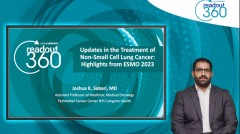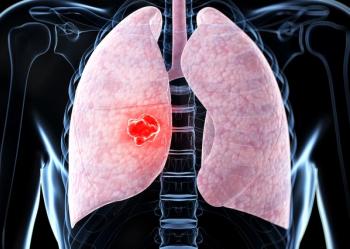
PAPILLON: Amivantamab Plus Chemotherapy in EGFR Exon 20 Insertion–Mutated Advanced NSCLC
Sandip P. Patel, MD, reviews recent data from the PAPILLON study investigating amivantamab plus chemotherapy in the first line for patients with EGFR exon 20 insertion–mutated advanced NSCLC.
Episodes in this series

This is a synopsis of a Readout 360 series featuring Sandip P. Patel, MD, of UC San Diego Moores Cancer Center; Joshua K. Sabari, MD, of NYU Langone’s Perlmutter Cancer Center; and Alexander I. Spira, MD, PhD, FACP, of Virginia Cancer Specialists.
Sandip P. Patel, MD, a professor in medical oncology at the University of California, San Diego, presented updates in the treatment of non-small cell lung cancer (NSCLC) from the ESMO [European Society for Medical Oncology] 2023 conference. The PAPILLON study, a randomized phase 3 trial presented by Girard and colleagues (abstract LBA5), evaluated amivantamab, an EGFR-MET bispecific antibody, plus chemotherapy versus chemotherapy alone as frontline treatment for patients with EGFR exon 20 insertion mutation advanced NSCLC.
Dr. Patel emphasized the importance of molecular testing in NSCLC, particularly in non-squamous NSCLC, and the need to identify specific mutations, such as the EGFR exon 20 insertion mutation. The PAPILLON study randomized patients 1:1 to receive carboplatin plus pemetrexed plus amivantamab, followed by maintenance amivantamab plus pemetrexed, or carboplatin plus pemetrexed alone with optional crossover to second-line amivantamab.
With a median follow-up of nearly 15 months, the median progression-free survival (PFS) was 11.4 months for the amivantamab plus chemotherapy arm versus 6.7 months for chemotherapy alone (hazard ratio [HR], 0.4). The 18-month landmark PFS was 31% for amivantamab plus chemotherapy compared to 3% for chemotherapy alone. The objective response rate was 73% for amivantamab plus chemotherapy versus 47% for chemotherapy alone (odds ratio, ~3). Median PFS2 was not estimable for the amivantamab plus chemotherapy arm versus 17.2 months for chemotherapy alone (HR, 0.49). An interim overall survival analysis, which was only 33% mature, showed a favorable trend for amivantamab plus chemotherapy (HR, 0.67; P = 0.1).
Dr. Patel noted the importance of monitoring toxicities, particularly pyrexia, skin toxicity, gastrointestinal toxicity, and infusion reactions, when combining multiple agents. The discontinuation rate of amivantamab due to treatment-related adverse events was 7%. Dr. Patel concluded that the PAPILLON study establishes amivantamab plus chemotherapy as a new frontline standard of care for patients with EGFR exon 20 insertion mutation advanced NSCLC.
*Video synopsis is AI-generated and reviewed by Cancer Network editorial staff.
Newsletter
Stay up to date on recent advances in the multidisciplinary approach to cancer.





















































































